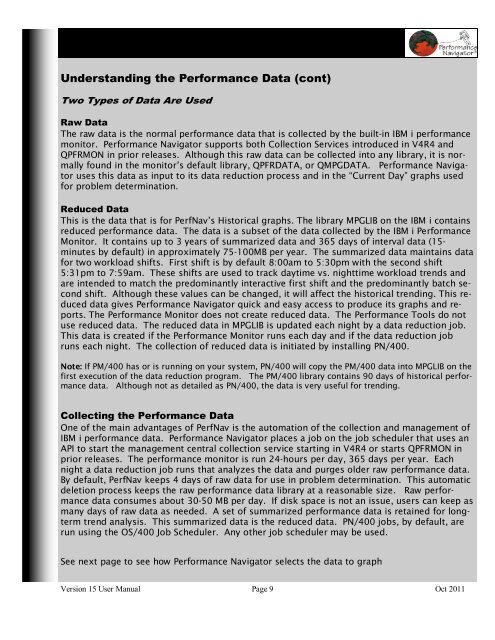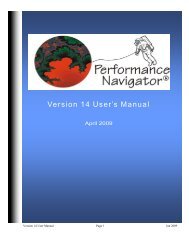Version 15.1 User’s Manual
Version 15.1 User's Manual - Midrange Performance Group
Version 15.1 User's Manual - Midrange Performance Group
You also want an ePaper? Increase the reach of your titles
YUMPU automatically turns print PDFs into web optimized ePapers that Google loves.
Understanding the Performance Data (cont)<br />
Two Types of Data Are Used<br />
Raw Data<br />
The raw data is the normal performance data that is collected by the built-in IBM i performance<br />
monitor. Performance Navigator supports both Collection Services introduced in V4R4 and<br />
QPFRMON in prior releases. Although this raw data can be collected into any library, it is normally<br />
found in the monitor’s default library, QPFRDATA, or QMPGDATA. Performance Navigator<br />
uses this data as input to its data reduction process and in the “Current Day” graphs used<br />
for problem determination.<br />
Reduced Data<br />
This is the data that is for PerfNav’s Historical graphs. The library MPGLIB on the IBM i contains<br />
reduced performance data. The data is a subset of the data collected by the IBM i Performance<br />
Monitor. It contains up to 3 years of summarized data and 365 days of interval data (15-<br />
minutes by default) in approximately 75-100MB per year. The summarized data maintains data<br />
for two workload shifts. First shift is by default 8:00am to 5:30pm with the second shift<br />
5:31pm to 7:59am. These shifts are used to track daytime vs. nighttime workload trends and<br />
are intended to match the predominantly interactive first shift and the predominantly batch second<br />
shift. Although these values can be changed, it will affect the historical trending. This reduced<br />
data gives Performance Navigator quick and easy access to produce its graphs and reports.<br />
The Performance Monitor does not create reduced data. The Performance Tools do not<br />
use reduced data. The reduced data in MPGLIB is updated each night by a data reduction job.<br />
This data is created if the Performance Monitor runs each day and if the data reduction job<br />
runs each night. The collection of reduced data is initiated by installing PN/400.<br />
Note: If PM/400 has or is running on your system, PN/400 will copy the PM/400 data into MPGLIB on the<br />
first execution of the data reduction program. The PM/400 library contains 90 days of historical performance<br />
data. Although not as detailed as PN/400, the data is very useful for trending.<br />
Collecting the Performance Data<br />
One of the main advantages of PerfNav is the automation of the collection and management of<br />
IBM i performance data. Performance Navigator places a job on the job scheduler that uses an<br />
API to start the management central collection service starting in V4R4 or starts QPFRMON in<br />
prior releases. The performance monitor is run 24-hours per day, 365 days per year. Each<br />
night a data reduction job runs that analyzes the data and purges older raw performance data.<br />
By default, PerfNav keeps 4 days of raw data for use in problem determination. This automatic<br />
deletion process keeps the raw performance data library at a reasonable size. Raw performance<br />
data consumes about 30-50 MB per day. If disk space is not an issue, users can keep as<br />
many days of raw data as needed. A set of summarized performance data is retained for longterm<br />
trend analysis. This summarized data is the reduced data. PN/400 jobs, by default, are<br />
run using the OS/400 Job Scheduler. Any other job scheduler may be used.<br />
See next page to see how Performance Navigator selects the data to graph<br />
<strong>Version</strong> 15 User <strong>Manual</strong> Page 9 Oct 2011




